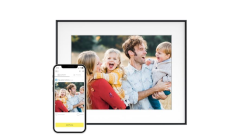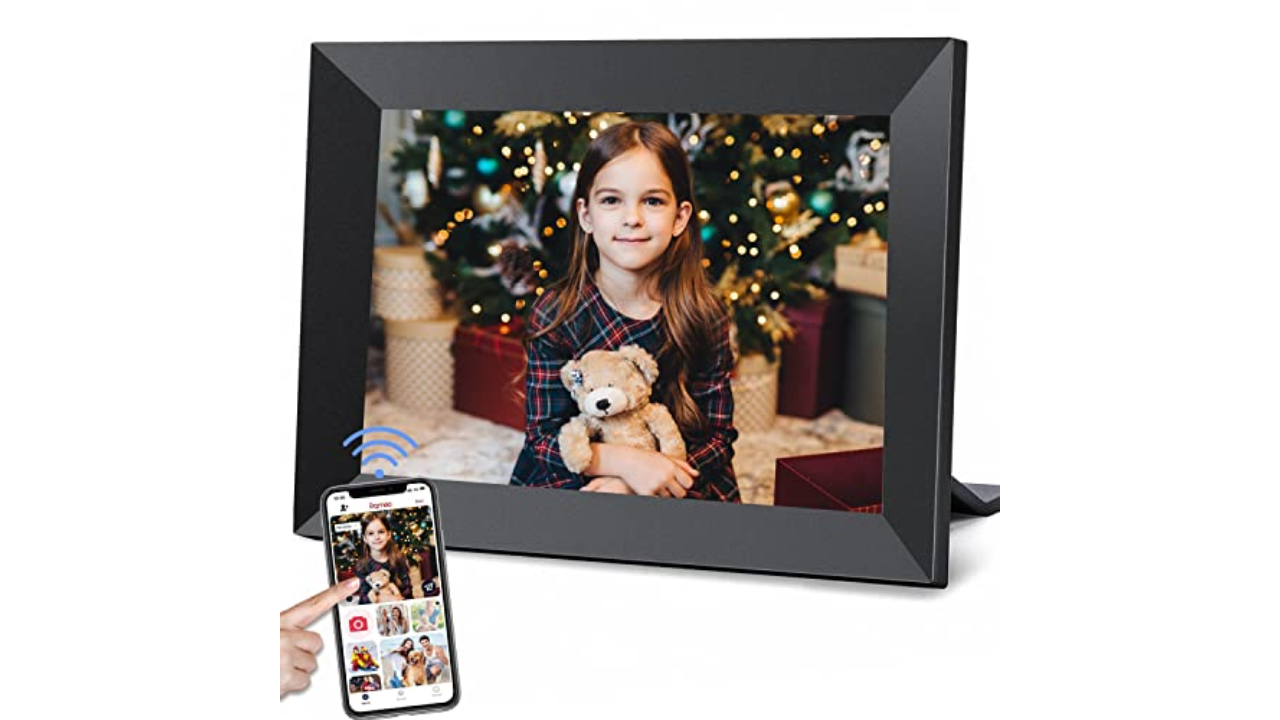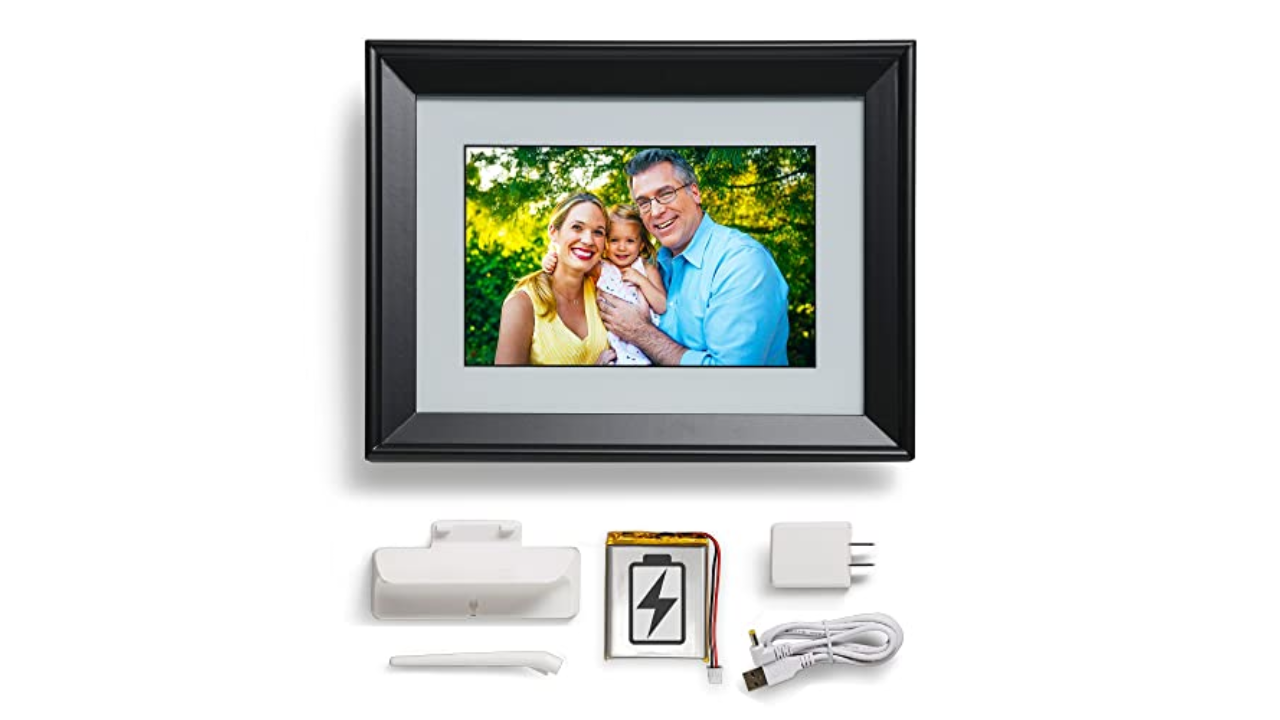We may earn commission from links on this page, but we only recommend products we believe in. Pricing and availability are subject to change.
The best digital picture frame in 2024: Relive precious memories all day, every day
Things I swear by: Chocolate is better than vanilla; Die Hard is not a "Christmas movie"; a digital picture frame is one of the best things you can own. Sure, I'll accept arguments on those first two, but go to my grave championing the screen that plays a running slideshow of your precious memories. Why should all those wonderful photos stay locked away in a phone or bulky old albums?
YunQiDeer Frameo 10.1-Inch Wi-Fi Digital Picture Frame
Best budget digital picture frame
Aura Walden 15-inch WiFi Digital Picture Frame
Best big digital picture frame
PhotoSpring 10 Charge Pro Portable Digital Picture Frame
Best portable digital picture frame
Loop 10-inch Digital Picture Frame
Best digital picture frame that can receive texts
Nixplay 10.1-Inch Digital Picture Frame
Best digital picture frame for extended families
The best digital picture frames aren't just for your snapshots, either; friends and family can send them as well, usually just with a few taps of an app (and your permission, of course). Part of the fun is spying new pics — or even videos — of the kids, grandkids, special events and so on that magically appear and play back over time.
Read more:
There are plenty of digital picture frames on the market, so which one should you put on your wish list? Consider one that's easy to "gift," meaning a friend or family member can preload it with photos — and maybe even preconfigure it for your home Wi-Fi network. That way, all you have to do is unpack it, plug it in and enjoy the (slide)show.
I've been testing and reviewing tech products for over 30 years, and during that time, I've owned or evaluated a lot of photo frames. I know what's most important when choosing one and what to avoid. This is a product category I'm especially passionate about; for me, it's right up there with TV soundbars.
Below, you'll find my picks for the best digital picture frames to buy for yourself or put on your wish list.
The best digital picture frames of 2024
Screen size: 10.1 inches | Resolution: 1,280 x 800 | Storage: 16GB (expandable) | Touchscreen: Yes | Orientation options: Landscape/portrait | Motion sensor: No | Dedicated email address: No
Amazon is home to dozens of off-brand photo frames like this one, with prices typically ranging between $60 and $100. I've chosen this model as representative of those "generics," the digital picture frames that all look pretty much the same and offer similar specs. The YunQiDeer is one of the better deals for a frame of this size.
Here you've got decent resolution, auto-rotation and expandable storage. To add photos to the frame, you use an app called Frameo, which is available for Android and iOS and admirably easy to use even if you aren’t tech-savvy. Friends and family will need to install the app as well in order to send their own photos (or video clips, up to 15 seconds in length). The frame lacks a dedicated email address.
What's more, the app doesn't flag photos you've already sent, so you'll have to manually review what's already on the frame to avoid sending duplicates.
Although Amazon shows a list price of $100, the frame routinely fluctuates between $60 and $80. So unless you're in a hurry, wait for a sale.
- Low price (and very often on sale)
- Stylish frame design
- Expandable local storage
- No integrations with social media or photo services
- New photos must be sent via app
Screen size: 15 inches | Resolution: 1,600 x 1,200 | Storage: Cloud (unlimited) | Touchscreen: No | Orientation options: Landscape/portrait | Motion sensor: Yes | Dedicated email address: Yes
Aura makes some of the most stylish photo frames you can get, so it's a bit surprising the company's new Walden model looks fairly plain: Just a basic black frame and white matte surrounding a roomy 15-inch screen.
But that screen is glorious, one of the brightest and sharpest I've seen, and Aura is still a top choice if you're looking for a gift: You can upload photos in advance and even set it up for use with the recipient's Wi-Fi network — great for grandparents or anyone who's not super tech-savvy. This works a little differently depending on whether you purchase from Aura proper or a retail partner like Amazon; be sure to read Aura's gifting page to learn more.
Setup is easy, and the Walden accepts photos from your phone, iCloud and Google Photos — but not Facebook, Instagram or other services. The Aura app is one of few that flags photos you've already sent, handy for avoiding duplicates. Friends and family can use that app as well, or send photos directly to the frame via email. The built-in motion sensor not only detects when people are present, but also adjusts screen brightness depending on the room's ambient light.
This is the rare frame that doesn't have a touch screen. All settings are managed in the app, though there are touch bars embedded on the top and side edges; you swipe these to page through your photos. I thought this a bit inconvenient at first, but it actually makes sense: It keeps the screen free of fingerprints.
Because the Walden relies solely on cloud storage, it requires a full-time Wi-Fi connection. If there's an outage, or you try setting this up somewhere without a Wi-Fi network, you won't be able to see any photos.
That's my only real complaint — and it's a minor one — with the Aura Walden, an excellent choice for yourself or as a gift.
- Easy to set up
- Can be preconfigured for gifting
- Big, beautiful screen
- Unlimited cloud storage with no monthly fees
- Must be connected to Wi-Fi
- Lacks the design flair of Aura's other frames
- Limited integrations
- Brightness setting can't be adjusted manually
Screen size: 10.1 inches | Resolution: 1,200 x 800 | Storage: 32GB (non-expandable) | Touchscreen: Yes | Orientation options: Landscape/portrait | Motion sensor: No | Dedicated email address: Yes
Photo frame to go? That's the unique promise of the PhotoSpring Charge Pro, the only model here with a rechargeable battery. You can not only use it at home, but also take it to, say, a party and run a photo slideshow as part of the celebration.
That's the standout feature in an otherwise basic frame, which looks a little dated and has software to match: The app is pretty rudimentary, offering few frame- or photo-management options; nearly everything is handled via the frame itself, which has an agreeably simple touchscreen interface. You can use a web portal to upload batches of photos, but it limits you to 500 at a time — a pretty major inconvenience if you have a large library to add.
What's more, although you can link to a Google Photos account, that's the extent of PhotoSpring's integrations: no Facebook, Instagram or the like. But I did notice that the Charge Pro is smart enough to detect and ignore duplicate photos, something I wish more frames did.
If you're looking for a photo frame that's intended to stay put, it's hard to recommend this one over others that have better software. However, if battery-powered operation is at the top of your list, the Charge Pro is your best — arguably only — choice.
- Quick and easy to set up
- Bright screen, wide viewing angle
- Can run up to four hours on battery power
- Doesn't support Facebook or Instagram
- Web uploader limited to 500 photos at a time
- Limited, outdated companion app
Screen size: 10 inches | Resolution: 1,920 x 1,080 | Storage: 16GB (non-expandable) | Touchscreen: Yes | Orientation options: Landscape only | Motion sensor: No | Dedicated email address: No
Every frame here can accept new photos via app; some also have dedicated email addresses, which simplifies things a bit for friends and family. The Loop relies on an app as well, but instead of email, it has a phone number, meaning you can actually send photos via text message — arguably the simplest solution of all.
Less simple: Frame setup, which was more complicated than it should have been owing to some conflicting instructions between the setup guide and the app. Thankfully, things went smoothly after that, and, in fact, the Loop proved one of the more novice-friendly frames I've used. The app and onscreen settings menus are simple and straightforward, allowing you to set up different albums and tweak things like photo transition time and sleep mode.
However, there are some limitations to consider. The frame works only in landscape orientation and doesn't have a motion sensor. It can display two photos side by side but doesn't offer any transition choices beyond a basic fade. Finally, although you can configure the Loop for gifting, you have to go all the way through the setup process first; you can't preconfigure and preload the frame like you can with Aura's.
My main complaint is that the app doesn't flag photos you've already uploaded to the frame, meaning you might accidentally send the same ones, resulting in duplicates. (Unfortunately, this is true with a lot of frames.)
These gripes aside, I like the screen’s brightness and the Loop's overall simplicity. And it's the only frame that lets you text new photos. That option alone may make it the preferred choice for some buyers.
- Sharp, bright touchscreen
- Dedicated phone number for receiving photos via text message
- App doesn't remember which photos you've uploaded
- Doesn't support portrait orientation
Screen size: 10.1 inches | Resolution: 1,280 x 800 | Storage: 8GB internal / unlimited (cloud) | Touchscreen: Yes | Orientation options: Landscape/portrait | Motion sensor: Yes | Dedicated email address: Yes
Nixplay has been in this biz as long as I can remember, so it's no surprise the company makes a damn fine frame. The current-gen 10-inch model looks lovely, with your choice of bezel and trim colors and even a stylish, patterned backside in case you display it somewhere you can actually see the back (like on an end table).
In my tests I found the Nixplay frame easy to set up, thanks to simple onscreen instructions that eventually lead you to the Nixplay app. The latter takes some learning, however, as it's heavily playlist-oriented and not super-intuitive overall. Even so, I think if you're looking to outfit not only yourself but one or more family members with a smart photo frame, this is a top choice. The app lets you set up "family circle" playlists for easy sharing between frames, plus you can pull photos from social networks like Facebook, Instagram and Google Photos.
I also like the frame's variety of display modes, which include fit-to-screen, pan-and-zoom and snapshot (which digitally frames each photo like a Polaroid and lays them down in a virtual, ever-growing pile). Most of these modes include nearly a dozen nifty transition options (push, wipe, cross-fade, etc.), including one that'll randomly cycle through them all.
Your frame purchase includes unlimited cloud service for your photos, though that means you need an active internet connection to see your full slideshow. Without one, the frame displays only your most recent additions, which are stored in local memory.
I did encounter a few image quality issues, starting with Nixplay's SmartFace Framing feature: It promises to automatically put faces near the center of the screen, but with some of my photos, it cut them off instead. Another oddity: SmartFace Framing can be enabled only via the frame's settings menu; it's not accessible in the app, even though most other display settings are. Meanwhile, the prominently featured Gift Prints option, which lets you order prints, photo books and the like, doesn't actually integrate with the Nixplay app. Instead, it leads you to a mobile browser, where ordering is a confusing process.
Of course, no frame is perfect, and I believe Nixplay's model makes a great choice for far-away families that want to easily exchange photos.
- Stylish frame and choice of colors
- Easy setup
- Family-friendly photo playlists
- Unlimited cloud storage
- App doesn't remember which photos you've uploaded
- Steep app learning curve
- Internet connection required to see full photo library
Digital picture frame FAQs
Factors to consider when buying digital photo frames
There are lots of choices, with prices starting as low as $50 and rocketing to nearly $300. So what's important? Here are the key features to consider when choosing a frame:
Size: The average photo frame measures about 10 inches diagonally, roughly the same as an entry-level iPad. I'd consider that the minimum size; anything smaller will make it hard to view photos from a distance. Indeed, when it comes to photo frames, bigger is almost always better.
Resolution: Similarly, the higher the frame's resolution display, the sharper your pictures will look. Don't settle for anything lower than 1,280 x 800 pixels; do look for 1,920 x 1,080 or higher if it fits your budget.
Aspect ratio: Although most modern phones can snap 1:1 (square) or 16:9 (wide) photos, the default setting tends to be 4:3. Some frames, however, have 16:9 screens, meaning you'll end up with black bars or similar cropping on some pictures. If you want the best chance of filling the screen from edge to edge, look for a frame with a 4:3 aspect ratio.
Wi-Fi: Sure, you can buy a frame for as little as $40, but it won't have Wi-Fi — meaning you'll have to manually add photos via your PC, a memory card or a USB stick. That's a huge hassle and just not worth it; definitely choose a frame that has Wi-Fi so you can easily add photos from your digital camera or phone (which is where most of them are kept anyway, right?).
Storage: Most frames come with at least 16GB of internal storage, which is enough to hold a couple thousand photos. If you think you'll need more space, look for one that's expandable (usually in the form of an SD card or microSD memory card) or offers cloud storage.
Dedicated email address: I'm a big fan of this option, which makes it easy for friends and loved ones to send their favorite photos to your frame. Some models use an app for this instead, but then your peeps have to install that app, learn to use it, etc. I like the email option better for its ease of use. Many frames can also directly import pictures from social media platforms like Facebook, Instagram and Google Photos, so look for that option if you have albums parked there.
Smart features: The best frames have smart-home features and can be set to go on and off at certain times of day (no sense running them at night when you're sleeping), while others have sensors that detect motion: They'll switch into a low-power standby mode until there's movement nearby. I also recommend frames that will automatically detect if they're positioned vertically or horizontally and adjust the view accordingly.
Design: Nearly all these gadgets look like actual picture frames, which makes them a much nicer addition to your decor than, say, a tablet or smart display (see below). Thus you'll see color options like white, wood grain, stone and even metallic. If you're thinking of wall-mounting it, keep in mind the power cord that'll need to run down (or through) the wall.
Subscription: I prefer frames that offer full functionality without any kind of subscription. Skylight, for example, makes a very popular model but limits various features unless you pay for Skylight Plus ($39 per year). Nixplay also has a subscription model, though it feels a lot more optional, adding nonessential perks like extra storage, product discounts and support for multiple frames connected to a single account.
Let's also address the rectangular elephant in the room: the screen you already have.
Why buy a digital picture frame instead of using a TV, tablet or smart screen?
Yep, I get this question a lot. Why not just use a tablet as a digital frame? Or a smart screen? Heck, what about the TV? You absolutely can, though be aware of some considerations and limitations.
As noted above, dedicated frames look like real picture frames. A tablet looks like, well, a tablet — not something I'd enjoy seeing propped up on an end table — and it's going to have limited slideshow capabilities. There are apps that can help, so this is worth a try if you've got an old tablet lying around, but be prepared for some hoop-jumping.
Read more: Amazon's $250 Echo Show 15 is a smart display for your wall
As for smart screens, all Amazon Echo Show and Google Nest Hub products have photo-slideshow capabilities, and in fact you can set that to be the fallback mode when the screen is idle. For me, the challenge lies in choosing what photos you actually want to display (the default is usually "everything" or "everything in a particular album") and then figuring out how best to add new photos. Looping in friends and family for the latter can be a struggle.
It's a similar story with TVs. Models from Amazon, Hisense, Roku, Samsung and the like all have a photo-slideshow mode that can be used as a screensaver, effectively turning the big screen into a picture frame when you're not watching The Last of Us. But as with smart screens, it's challenging to queue up exactly the photos you want, add new ones and invite others to contribute. Plus, big televisions consume considerably more electricity than digital frames, something to consider if you're leaving it on all day.
All that being said, there's no harm in experimenting with the screen you already have. I remain a fan of the dedicated photo frame, but in the end, the goal is to see your snapshots once in a while — and a tablet, TV or smart screen can definitely help you do that.
Do you need internet for a digital picture frame?
Yes, all modern frames require an internet connection (by way of your home Wi-Fi network), because that's how they're able to receive new photos and software updates. Granted, some models also have a USB port and/or SD card slot, which would allow you to view photos stored on a flash drive or memory card. Others (notably those from Aura) store the bulk of your library in the cloud, meaning internet is essential.
How many pictures does a digital picture frame hold?
This varies from one frame to another and typically depends on how much local storage is available — typically anywhere from 8GB to 32GB. Even with just 8GB, a frame could likely hold a couple thousand pictures.
As noted above, some frames rely in part (or in whole) on cloud storage, effectively allowing an unlimited number of pictures.
How I tested digital picture frames
Most of these frames are pretty easy to use: Plug them in, install the companion app on your phone, get connected to Wi-Fi, start uploading photos. But clear, illustrated instructions are important, so that was the first thing I looked for.
From there, I evaluated overall screen quality (brightness, sharpness, viewing angle, etc.) as well as the appearance of the frame itself. Did it seem modern or old-fashioned? Would it suit any decor?
I also paid special attention to each frame's app because that's likely to be your primary tool — and the tool for friends and family — for uploading photos. Some are easier to use than others; some are smart enough to flag photos you've already uploaded, the better to avoid duplicates. I'm not saying that feature is essential, but it certainly is useful.














